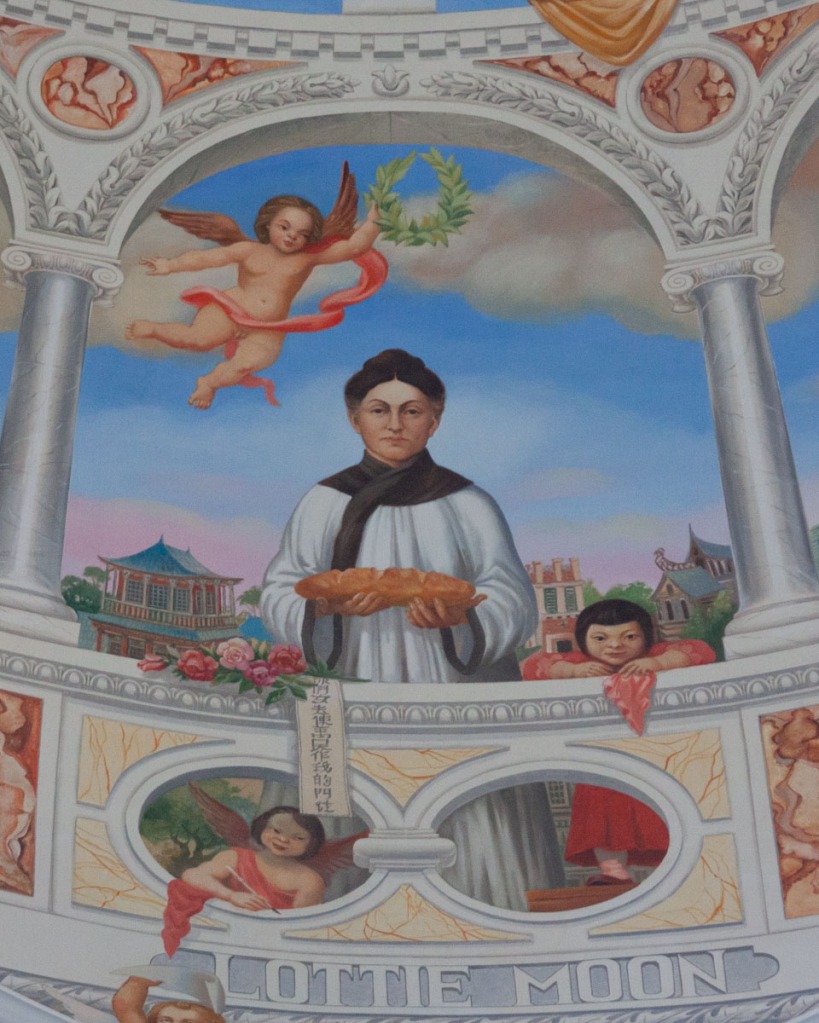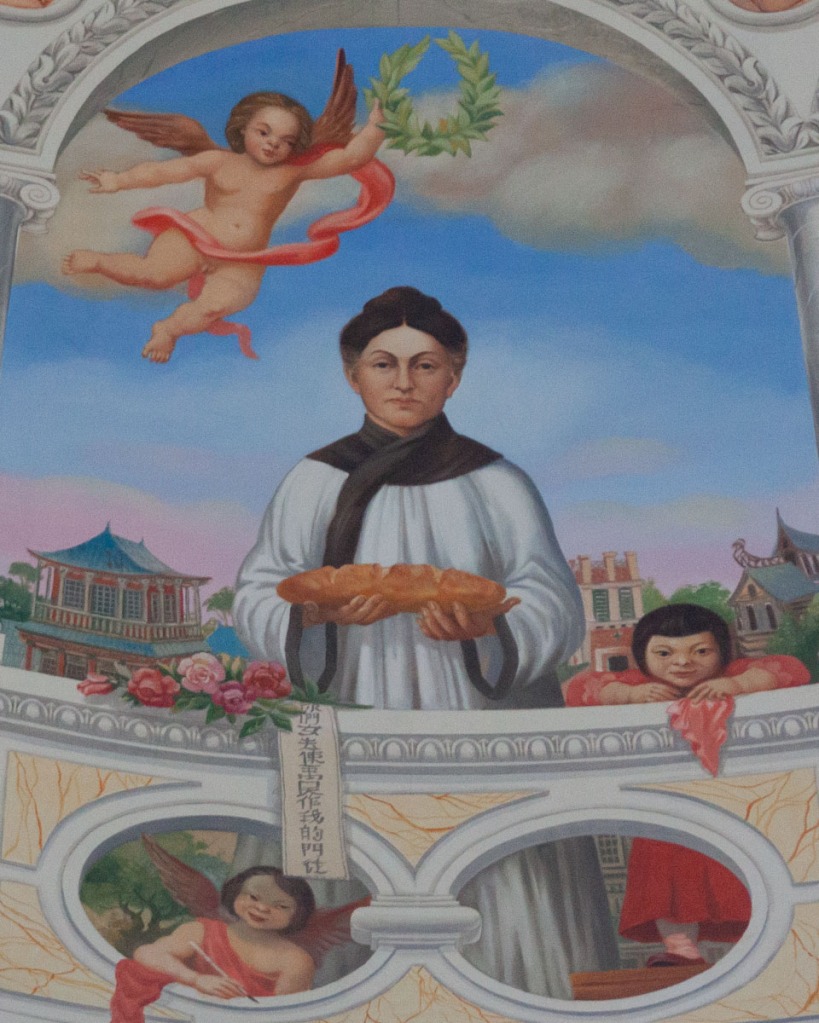The Pioneer Missionary Woman
By Emma Powell
The image of Lottie Moon on the dome of Hodges Chapel at Samford University beautifully reflects her dedication and devotion to the people of China. Her generosity and humility to the Chinese earned their respect as well as honor amongst the Southern U.S. communities she wrote to and influenced from afar.
Moon’s Baptist Network
Charlotte “Lottie” Moon was a traditional Southern Baptist woman born in 1840. She played a pivotal role in enabling American women to serve on the mission field and on how international missions was perceived by Protestants in the United States. Her work and dedication to the mission field have been discussed for decades and her legacy of service continues to live on through an annual Christmas offering begun to support her and others in 1888 and named for her in 1918. The funds raised through this offering are the single largest component of the Southern Baptists Convention’s contribution to foreign missions (Allen 1993). Though Lottie Moon is not often referred to by the title of “saint,” she is represented in Hodges Chapel with some who are always called saints along with other important Christians such as Protestant reformers such as Martin Luther and John Calvin.

Various organizations were connected to Lottie Moon and still honor her to day. She came to faith and was called to mission within the Southern Baptist Convention (SBC) and remained within this denomination her whole life. In 1873, when she left for China, there were many questions about her position because many women at that time had no rights in religious or political spheres (Sullivan 2011, 1-53). Moon never married, which also raised concerns as most missionaries followed their husbands overseas. However, Moon also had a massive impact on the SBC’s Foreign Mission Board (known since 1997 as the International Mission Board). In time, it would increase the number of female missionaries due to her inspiration (Magnuson 2022). All her efforts would lead to the formation of the Woman’s Missionary Union, which formed despite the struggle to enter a male dominated field. This organization was inspired by Moon and would lead to what was considered one of the first feminist movements advancing women’s roles in professional religious work (Sullivan 2011).
Her Time in China
Moon spent nearly forty years overseas in China serving various villages and provinces. She truly felt that this was her higher calling because the Chinese she served needed a savior. She felt that Christians had neglected this call to action (Magnuson 2022). Moon wrote home as frequently as possible, and every letter included encouragement to send help to join her on the front lines of a war to share the gospel. The communities she served suffered from both financial poverty and poverty of a savior, Moon desperately wanted to share the rich message of Jesus with the young women she met.
Most of her letters back home were addressed to the corresponding secretary of the Foreign Mission Board, Dr. Henry Allen Tupper, who would often assist her with finances and transferring money overseas (Moon and Harper 2002, 6). She would also address her letters to wives of pastors that were involved in these various organizations to encourage them of their own worth in the church and to use their voices to convince their husbands to recognize the need to help foreign missionaries. Contrary to a common misconception, Lottie Moon did not spend all of this time working alone. Being the only female on the field did motivate the sharing of her story, but she partnered with many male missionaries sent by the Foreign Mission Board. She explained in her letters that many of these long-term missionaries, including herself, were aging and needed young shoulders to be sent to carry the weight of the communities that the Foreign Mission Board was committed to keep assisting (Moon and Harper 2002, 304-305).
Moon’s Image in Hodges Chapel
Because of her fame and commitment, Moon is one of the sixteen Christians chosen to be honored in the dome of Hodges Chapel. Perhaps the most noticeable feature of depiction is that she is surrounded by three small children. Two of these children are winged. They are among the many cherubs in the dome. They represent the innocence and purity of Moon’s mission and the people she was helping. Her focus on women and children is also suggested by a Chinese child standing on her right.

Lottie Moon’s nearly forty-year career in China is also represented by the Chinese architecture style of the three buildings behind her. She was always known as extremely respectful of the culture which she was surrounded and for being kind and generous. The traditional robe Moon wears, and the Chinese writing to her right represent these traits. These qualities made it apparent that “Lottie did not just serve the people of China; she identified with them.” making her a more respected figure of their societies (Magnuson 2022).
It is recorded that Moon had become extremely sick in the months leading up to her death on Christmas Eve 1912. Many indications in her letters, along with reports from those close to her, indicate that the cause was malnourishment. She likely suffered this malnourishment because she gave away her meals to people she thought were more hungry and more deserving. Thus, the loaf of bread she holds and offers to the viewer represents both her generosity and her giving of her life for others. . A well-known story states that she gave away a loaf of bread, her only source of food, days before she died. Her death in the cause of the gospel is represented by the wreath of laurels above her head. The only other figure so honored in the dome is the martyr Thomas Cranmer.
Conclusion
While Samford is a Baptist university, Moon is one of only two Southern Baptists depicted in the dome, the other being John Leland. This dramatizes the high honor in which she is held in Southern Baptist life. Though over time fewer students on Samford’s campus are aware of the story and importance of Lottie Moon’s name, her inclusion in the dome ties together lots of values familiar to the campus. These include women’s missions, Southern Baptist faith, and global engagement. These are all present throughout the Samford community. She is also one of the two women out of the sixteen “witnesses” honored with their own painting in the dome of the Chapel. The other Perpetua is an early third-century martyr. This furthermore dramatizes the importance of Lottie Moon, since most women before the 1920s did not play a prominent public role in church history or reformation movements. Moon reformed the church by creating a larger role for women. She is so much more than the Christmas offering for which she is known for today and that is why she is one of the sixteen Christian heroes in the dome of Hodges Chapel.
Lottie Moon dedicated all she had to spreading Christianity through love and kindness a world away from her home. The legacy of her generosity to others is still present today as churches across the US make donations the week before Christmas to send to missionaries overseas through the Lottie Moon Christmas Offering. She is recognized in the dome of Hodges as a symbol and lesson to all viewers to the higher calling placed upon each of us to follow God’s will.
Lottie Moon
Medium: painting
Artist: Petru Botezatu
Created and Installed: c. 1995
Location: Andrew Gerow Hodges Chapel, Samford University, 800 Lakeshore Drive, Birmingham Alabama, 35229
References
Allen, Catherine. 1993. “The Legacy of Lottie Moon.” International Bulletin of Missionary Research 17 (4): 146-152. https://doi.org/10.1177/239693939301700401.
Magnuson, Seth. “Who Was Lottie Moon?” IMB, October 19, 2022. https://www.imb.org/about/lottie-moon/.
Moon, Lottie, and Keith Harper. Send the Light: Lottie Moon’s Letters and Other Writings. Macon, GA: Mercer University Press, 2002.
Samford University. Andrew Gerow Hodges Chapel [Guidebook] Birmingham, AL: Samford University. Accessed September 18, 2023. https://www.samford.edu/beeson-divinity/files/hodges-chapel-guidebook.pdf
Sullivan, Regina D. Lottie Moon: A Southern Baptist Missionary to China in History and Legend. Baton, Rogue: Louisiana State University Press, 2011.
Emma Powell ‘27 was a student in UCS 102: Icons & Memorials in Samford University’s Howard College of Arts & Sciences in fall 2024.
Very interesting
LikeLiked by 1 person